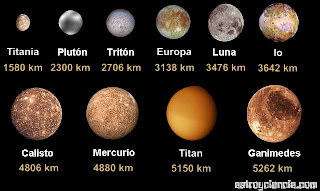PLANETS
Mercury.
Is the
innermost planet in the Solar System. It is also the smallest, and
its orbit is the most eccentric (that is, the least perfectly circular) of
the eight planets.
Venus.
Is the second planet from the sun in order of distance from the Sun, and the third in terms of size, from smallest to largest. It is named in honor of Venus, the Roman goddess of love. It is a rocky planet Earth type, often called the Earth's sister planet because both are similar in size, mass and composition, but totally different in thermal and atmospheric issues.
Earth.
Is the
third planet from the Sun, and the densest and
fifth-largest of the eight planets in the Solar System. It is also the
largest of the Solar System's four terrestial planets. It is sometimes referred
to as the world, the Blue Planet.
Earth
formed 4.54 billion years ago,
and life appared on its surface within one billion years. The planet
is home to millions of species, including humans.
Mars.
Is the fourth planet from the Sun in the Solar System. Named after the Roman God of War, it is often described as the "Red Planet", as the iron oxide prevalent on its surface gives it a reddish appearance. Mars is a terrestial planet with a thin atmosphere, having surface features reminiscent both of the impact craters of the Moon and the volcanoes, valleys, deserts, and polar ice caps of Earth.
Is the fourth planet from the Sun in the Solar System. Named after the Roman God of War, it is often described as the "Red Planet", as the iron oxide prevalent on its surface gives it a reddish appearance. Mars is a terrestial planet with a thin atmosphere, having surface features reminiscent both of the impact craters of the Moon and the volcanoes, valleys, deserts, and polar ice caps of Earth.
Jupiter.
Is the fifth planet from the Sun and the largest planet within the Solar System. It is a gas giant with mass one-thousandth that of the Sun but is two and a half times the mass of all the other planets in our Solar System combined. Jupiter is classified as a gas giant along with Saturn, Uranus and Neptune. Together, these four planets are sometimes referred to as the Jovian or outer planets.
Is the fifth planet from the Sun and the largest planet within the Solar System. It is a gas giant with mass one-thousandth that of the Sun but is two and a half times the mass of all the other planets in our Solar System combined. Jupiter is classified as a gas giant along with Saturn, Uranus and Neptune. Together, these four planets are sometimes referred to as the Jovian or outer planets.
Satrun.
Is the sixth planet from the Sun and the second largest planet in the Solar System, after Jupiter. Named after the Roman god Saturn, its astronomical symbol (♄) represents the god's sickle. Saturn is a gas giant with an average radius about nine times that of Earth. While only one-eighth the average density of Earth, with its largervolume Saturn is just over 95 times as massive as Earth.
Is the sixth planet from the Sun and the second largest planet in the Solar System, after Jupiter. Named after the Roman god Saturn, its astronomical symbol (♄) represents the god's sickle. Saturn is a gas giant with an average radius about nine times that of Earth. While only one-eighth the average density of Earth, with its largervolume Saturn is just over 95 times as massive as Earth.
Uranus.
Is the seventh planet from the Sun. It has the third-largest planetary radius and fourth-largest planetary mass in the Solar System. It is named after the ancient Greek deity of the sky Uranus, the father of Cronus (Saturn) and grandfather of Zeus (Jupiter). Though it is visible to the naked eye like the five classical planets, it was never recognized as a planet by ancient observers because of its dimness and slow orbit.
Is the seventh planet from the Sun. It has the third-largest planetary radius and fourth-largest planetary mass in the Solar System. It is named after the ancient Greek deity of the sky Uranus, the father of Cronus (Saturn) and grandfather of Zeus (Jupiter). Though it is visible to the naked eye like the five classical planets, it was never recognized as a planet by ancient observers because of its dimness and slow orbit.
Neptune.
Is the eighth and farthest planet from the Sun in the Solar System. It is the fourth-largest planet by diameter and the third largest by mass. Neptune is 17 times the mass of Earth and is somewhat more massive than its near-twin Uranus, which is 15 times the mass of Earth but not as dense. On average, Neptune orbits the Sun at a distance of 30.1 AU, approximately 30 times the Earth–Sun distance.
Is the eighth and farthest planet from the Sun in the Solar System. It is the fourth-largest planet by diameter and the third largest by mass. Neptune is 17 times the mass of Earth and is somewhat more massive than its near-twin Uranus, which is 15 times the mass of Earth but not as dense. On average, Neptune orbits the Sun at a distance of 30.1 AU, approximately 30 times the Earth–Sun distance.





